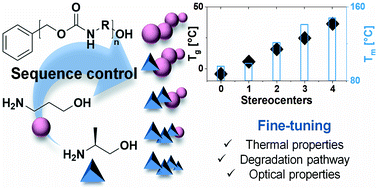Discrete oligourethanes of sequence-regulated properties – impact of stereocontrol†
Abstract
Properties and functions of natural biopolymers such as proteins are strongly dependent on the sequence of amino acid monomers. The regulation of the properties of synthetic polymers by controlling monomer composition and order in macromolecule chains is a very intriguing approach that has not been thoroughly investigated so far. It is not understood to which extent we can control the properties of synthetic macromolecules by changing their sequence and stereochemistry. Moreover, compared to the classical polymerization protocol, a multistep synthesis leading to perfectly sequence-defined macromolecules has many restrictions. The synthesis limitations inhibit studies of the properties and applications of sequence-defined macromolecules. Here, we investigated oligourethane models to learn about a sequence–property relationship and how stereocontrol can influence their characteristics. We have simplified the solution synthesis protocol by limiting purification steps; therefore, the oligomers can be obtained on a large scale, with good yield and high purity. We found that monomer sequence composition can be used as a tool for regulating the thermal properties of oligourethanes and can influence the degradation pathway. By inducing chirality into macromolecules we can precisely program hydrodynamic volume, thermal characteristics, and optical activity.



 Please wait while we load your content...
Please wait while we load your content...